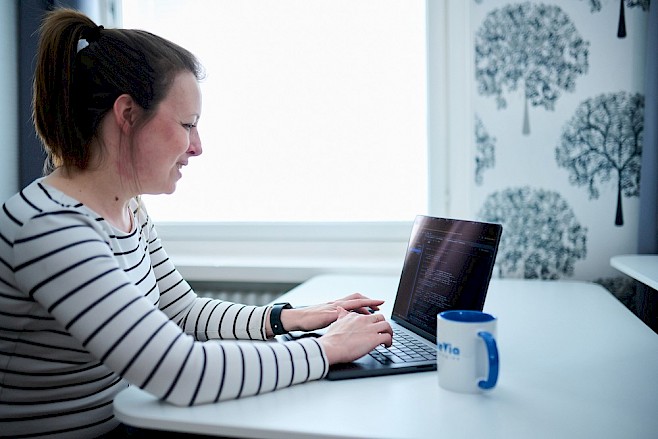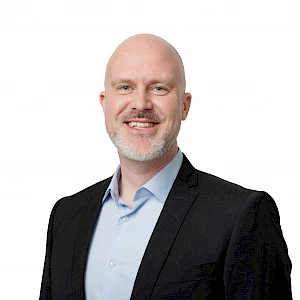Bioinformatics Career Story: Patricia Thomas
Genevia’s Scientific Project Manager, Dr. Patricia Thomas, combines creativity, problem-solving, people skills, and years of lab and clinical experience to turn complex data into insights. Her journey from a career in hairdressing to diabetes research and bioinformatics is a testament to following passion wherever it leads.
 Dr. Patricia Thomas
Dr. Patricia Thomas
Falling for Science: from Hairdressing to Diabetes Research
When Patricia joins our video call from Birmingham, UK, she smiles and warns: “It’s actually quite a long story.”
School was not straightforward for Patricia. Neurodiversity made studying challenging, and after struggling through her teenage years, she left school early to become a hairdresser. Creativity, quick learning, and ambition soon propelled her into fashion shoots, teaching, and runway shows.
“I loved the job. But while my creativity was met, I started to feel that my intellectual side wasn’t,” she recalls. “So I began taking online science courses—and I fell in love with it. I fell in love with the cell: how messy, complex, and beautiful it was.”
At 26, Patricia enrolled in a degree in Dietetics, with a 1000 hours of clinical training within the National Health Service (NHS). She next earned a Master’s degree in cellular and molecular physiology at the University of Liverpool. Time in a diabetes clinic left a deep impression.
“It was brutal. Even though type 2 diabetes is extremely common and quite normalized in society, I saw people coming in with severe complications; there were amputations, blindness, and kidney failure. I decided that, even if it was in a small way, I wanted to help these people,” Patricia says.
This experience inspired her to pursue a PhD under Professor Noel Morgan, a leading diabetes researcher at the University of Exeter. Her research focused on how long-chain saturated fatty acids damage insulin-producing pancreatic beta cells in a process called lipotoxicity. A particular discovery captivated her: lipid droplets.
“It has been known for a long time that type 2 diabetes is often induced by obesity; in part it's about how fats are trafficked within the intracellular organelles, especially how fats are stored within the pancreas. I found these small intracellular bodies, lipid droplets, forming in people with type 2 diabetes, and we figured they might be a protective mechanism. For a long time, they were overlooked; now we know that they’re not only storing fats, but also acting as major signaling hubs. This finding really fueled my love for science: every time I saw lipid droplets under the microscope, knowing I was one of the first people to observe them in dysfunctional insulin producing beta cells, it blew my mind.”
During her doctoral research, Patricia encountered data analysis on a new scale.
“I was using a Seahorse extracellular flux analyzer, measuring mitochondrial respiration, and it produced mountains of data. Analyzing one dataset manually took forever. I thought, this is ridiculous—I need code. So I started taking courses in basic programming, and I found it so much fun.”
Her enthusiasm led to a six-month Wellcome Trust funded secondment focused on coding and single-cell RNA-seq data analysis—a novel technology at the time—followed by a research stint at the University of Michigan in collaboration with NIH in the U.S., where she learned more about statistical modeling. After returning to finish her PhD, she spent five more years deepening her expertise in bioinformatics and image analysis at the University of Birmingham, climbing the academic ladder to become a principal investigator.
“I slowly realized that the higher you climb, the more admin you do—and I love science itself. I was trained to be a scientist, and all I wanted to do was science.”
Science without Distractions
Through a friend, Patricia learned about Genevia Technologies:
“My friend, who is an amazing bioinformatician herself, spoke so highly of the company and the people. I knew I’d get to work with brilliant scientists on exciting projects.”
Since joining in July 2024, Patricia has worked across a wide range of projects, with a focus on transcriptomics. One of her favorite projects so far? A challenging, neuroscience-related project for a large pharma company.
“It was one of the biggest projects I’ve ever done, but also the most rewarding. The client was incredibly skilled in his field, and I learned so much. Also, my background was a great match for the project: I studied neuroscience in my Master’s, and beta cells are essentially neurons of the pancreas.”
She describes her first year at Genevia as a steep learning curve, not only in terms of data analysis, but also in adapting to working in industry. Her varied experiences have been an asset:
“My clinical and lab experience help hugely in my current role. When talking to clients, I understand what goes into generating data, and what can affect it, which is really advantageous. And hairdressing taught me how to talk to people from all walks of life: working in science, knowing your audience and knowing how to pitch things is a skill in itself,” she says. She adds: “In addition, at Genevia, I’ve learned a lot about computer science from a non-biology perspective. Having the support and being given the time to learn is such a blessing.”
Keeping Pace with a Fast-Moving Field
Patricia is passionate about staying on top of the latest trends in her field, and continuously learning new things, especially in single-cell and spatial transcriptomics.
“Single-cell is what I’m the most confident with, and it’s been really lovely having my career grow alongside the field. Now I’m on that journey with spatial as well, which is really exciting, and I’m keen to learn more about proteomics too.”
Her experience with super-resolution microscopy makes spatial methods particularly compelling:
“It is fascinating how spatial transcriptomics overlaps with the field of image analysis. It’s a privilege to watch a new technology evolve, and, in a way, play a small part in that progress. I’m very excited to see where the field goes.”
Staying up to date in such a fast-evolving field is no easy task, but Patricia finds the community extremely helpful:
“Especially with single-cell and spatial technologies, things are advancing so rapidly that you can’t pause for six months or you’ll fall behind. You simply have no other choice but to try and keep up, learn about new packages and read papers. What really helps me with this is our single-cell and spatial group at Genevia, with whom we share insights and experiences. One of the most beautiful things about bioinformatics is the community: everything is about furthering the field for the greater good. There are so many open source resources online, many people upload conference talks to YouTube, and many post on LinkedIn about the papers and packages they’ve developed.”
Life as a Remote Scientist
Despite initial concerns about working remotely, Patricia has adapted well.
“I’ve actually noticed that I get a lot more done when I’m working from home, because I’m not just chatting to people constantly,” Patricia laughs. “And still, I feel connected through Slack and video calls. Our team is just lovely, such a nice bunch of people. It means a lot to me to get to work with people who are equally passionate about bioinformatics and good science,” she reflects.
Patricia’s typical working day starts with lots of coffee: according to her, coffee fuels science. Then, she takes a look at her notes from the day before, checks in on Slack, sends any emails that need to be sent, and dives into the analysis.
“In my office, I get into this zone where I’m so focused and engaged that I forget that I’m actually at home. At the end of the day, it feels really nice to step out, like coming back to the real world.”
She also enjoys the degree of freedom that remote work brings:
“I am a runner, and I’m currently training for a half marathon. I love being able to take my long runs during lunch breaks.”
Outside work, Patricia balances science with creativity and time with loved ones:
“I’m a scientist, a runner, but also an artist. I’ve had a gallery exhibition, and I’m very lucky to have a lovely art studio in my back garden. I’m a grade-eight pianist as well, so I play piano a lot. And then, obviously, I love spending time with my friends, family, and my partner, who’s my favourite person in the world. So yeah, I have a very good work-life balance; to do science, you need your brain in optimal condition.”
Advice for Aspiring Bioinformaticians
Patricia highlights resilience as the key to success in bioinformatics.
“There will be things that go wrong and bugs in your code. You’ll have to find ways to make the analysis run as fast as it can, and keep up with new packages. An important skill is to try and visualize in your head what the code is doing and how you’re going to work it out. It’s fun solving these problems—I really relish it—but sometimes it can be mentally very difficult to work out a problem up against the clock,” she says.
Moreover, Patricia stresses the importance of learning multiple programming languages: you will need different tools for different analyses, and even if you specialize in a specific data type, each dataset is unique. Knowing your languages well will make it easier to adapt your knowledge to new situations.
Above all, Patricia emphasizes that loving what you do matters most:
“Most bioinformaticians that I know started in wet labs and switched to bioinformatics out of love for the field. As one professor told me: the people who succeed are not the most intelligent, but the ones with the fire in their belly. If you’re passionate about something, listen to that passion and keep going. The passion will drive you where you want to be.”
Read more
Contact us
Leave your email address here with a brief description of your needs, and we will contact you to get things moving forward!

